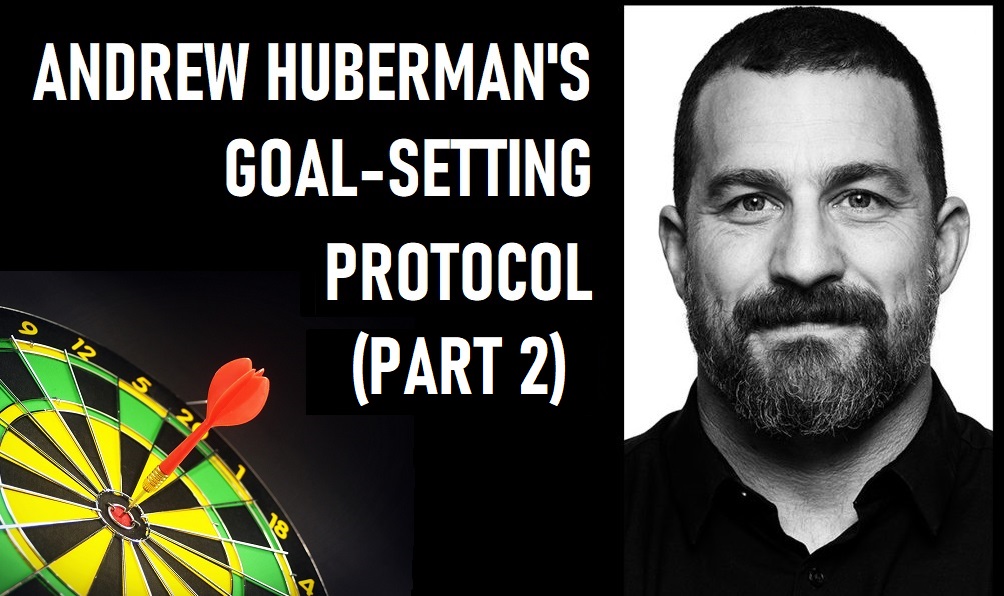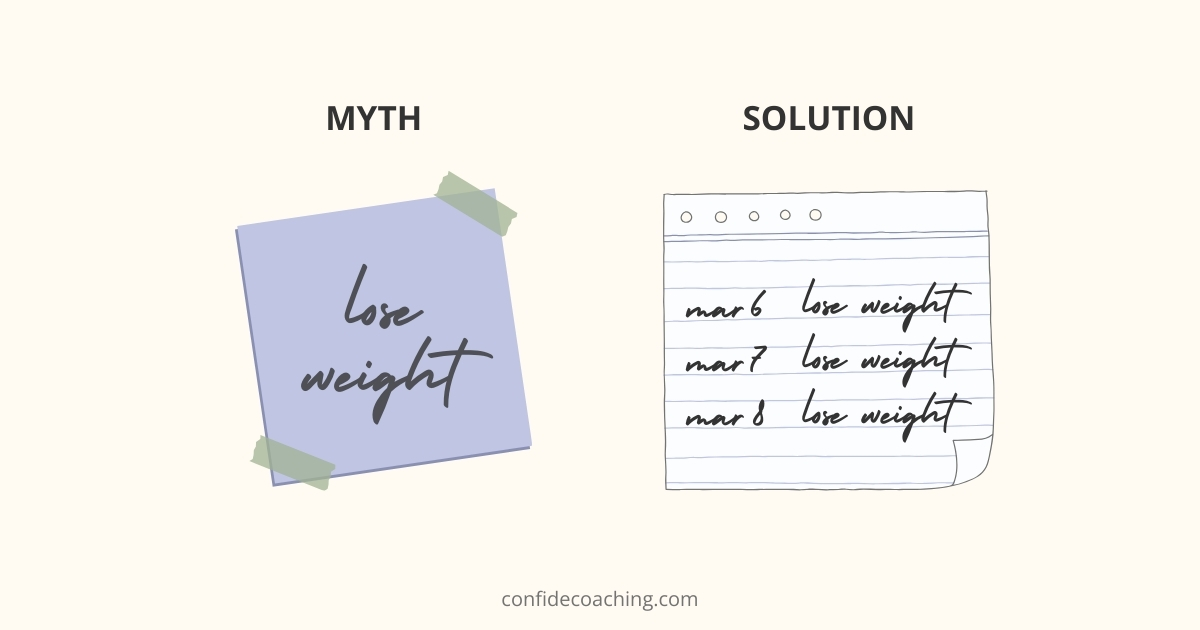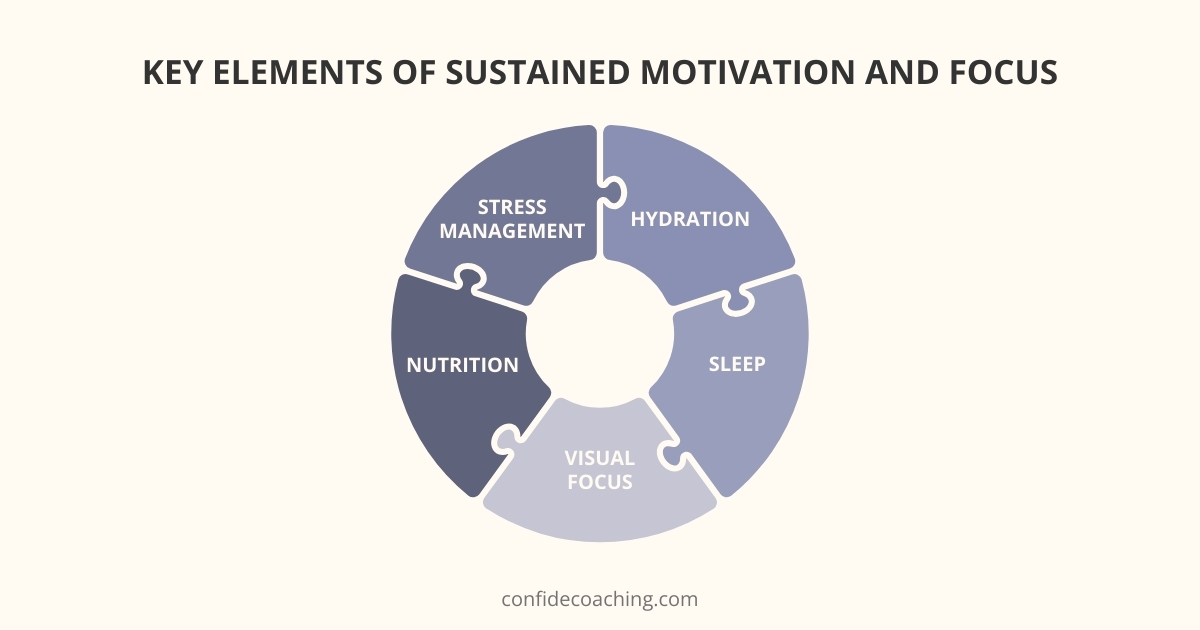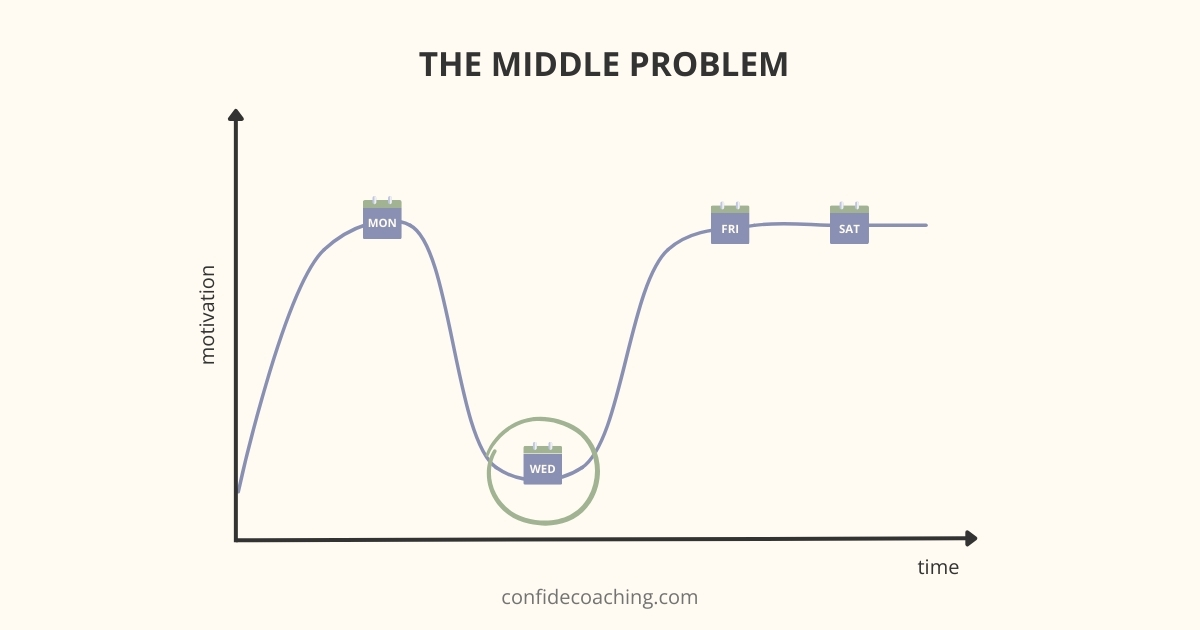
In our previous discussion on goal-setting, we delved deep into Dr. Andrew Huberman’s transformative perspective on converting broad aspirations into actionable tasks. By shifting our mindset from nebulous “title goals” like “I want to be successful” or “I wish to be fit,” to verb-driven objectives, such as “I will run three times a week,” we transition from mere dreaming to practical doing.
Dr. Huberman also emphasized the profound neurological impact of handwriting our goals, illustrating its unparalleled power in strengthening our connection and commitment to them. This physical act engages specific parts of our brain, reinforcing memory, focus, and intentionality, ultimately paving the path for genuine achievement.
The 12-week or quarterly cycle was introduced as an effective periodization for concentrated effort, aligning with societal, work, and even seasonal rhythms.
But as we venture deeper into the intricacies of goal-setting, several myths cloud our understanding, potentially derailing our progress. Moreover, beyond the foundational practices, what are the precise tools, backed by scientific understanding, that can truly amplify our chances of success? In this article, we’ll explore and debunk the common myths surrounding goal-setting.
We’ll also unveil Dr. Huberman’s top science-backed strategies designed to guide us efficaciously to our desired outcomes.
Debunking Common Goal-Setting Myths
Navigating the journey towards achieving one’s goals can be complicated by misconceptions. As we steer the path of purposeful goal-setting, it’s essential to dispel some widely accepted myths that may not only be ineffective but counterproductive. Dr. Andrew Huberman sheds light on these common fallacies, guiding us toward a more efficient approach.
Visual Reminder “Post-It” Myth
The Misconception:
Writing your goal on a Post-it and sticking it where you frequently see it acts as a constant visual cue, prompting action toward the goal.
The Reality:
Due to the adaptability of our nervous system, after a couple of days, these notes simply blend into the environment, fading from our active attention.
The Solution:
- Handwrite your goal daily. The repeated act of writing reinforces the goal’s importance in your mind.
- If you like using visual reminders, post this freshly written note in a different location every day to prevent it from becoming just another unnoticed item in your surroundings.

Accountability Myth
The Misconception:
Publicly declaring or sharing our goal with close ones will hold us accountable, thereby increasing the likelihood of achieving it.
The Reality:
Announcing our aspirations can activate reward systems in the brain prematurely. We might experience a rush of dopamine, giving us a false sense of achievement and satisfaction. This short-lived elation can be quickly followed by a decrease in motivation.
The Solution:
- Avoid revealing your goals before taking the first actionable steps toward them.
- Prioritize defining your goal clearly and writing it down on paper. Recall Dr. Huberman’s emphasis on the neurocognitive benefits of handwriting your objectives.
- Exercise caution in sharing goals with naysayers. Their skepticism can harm your intrinsic motivation, even if you’re trying to prove them wrong.
These myths highlight the importance of a grounded, science-backed approach to goal-setting. While the allure of quick fixes and popular advice can be tempting, a deeper understanding of the neurological processes behind goal achievement can set us on a more effective and fulfilling path.
How to Use Focus to Increase and Sustain Motivation
Our visual system plays a pivotal role in how we approach our goals and maintain motivation. By understanding how the visual focus impacts our cognitive processes, we can harness its power to achieve our objectives more effectively.
The Science Behind Visual Focus
- When you narrow your visual attention to a specific point in front of you, you stimulate the release of neurochemicals from the brain stem. This enhances your overall level of alertness in both the brain and body.
- Shifting to panoramic vision, on the other hand, ceases the release of these neurochemicals. This state can lead to distractions, like daydreaming, and a reduced focus on the current task.
- Engaging in sustained visual focus has several benefits:
- Deployment of neurochemicals from the brain stem.
- Increased level of autonomic arousal.
- Release of dopamine and associated molecules elsewhere in the brain, promoting focus and motivation.
Applying Visual Focus in Goal Pursuit
If motivation starts to decline during a task, consider implementing the following visual focus strategy:
- Select a Visual Target: Choose a point within the physical environment that corresponds with your task.
- Distance Appropriateness: The target’s distance should mirror that of your actual work. For instance:
- Reading a paper? The target could be a specific word or symbol on the same page.
- Engaged in sports? Opt for a point a few meters away.
- Working on a computer? Perhaps it’s an object or a spot on your desk.
- Hold Your Gaze: Once you’ve chosen your target, focus intently on it. Use a timer to track your progress. Initially aim for 30 seconds, advancing to 90 seconds as you become more adept.
Note: Maintaining visual concentration can become fatiguing when performed for a prolonged time. Here are a few tactics that Dr. Huberman recommends as proactive relaxation:
- Blinking: Always remember to blink naturally throughout. It helps in keeping your eyes moistened and comfortable.
- Regular Breaks: Consider incorporating intervals into your routine. For instance, every 20 minutes or every hour, pause your current activity. Dedicate 30 to 60 seconds to visual target training before resuming your task. These breaks not only refresh your eyes but can also rejuvenate your motivation.
- Rest Your Eyes: If your eyes start to feel strained, switch to a panoramic vision mode. This approach involves relaxing your eyes and expanding your field of view. If you can, step outside and gaze upon the horizon without fixating on a particular point. This practice aids in breaking the vergence eye movement, which can lead to fatigue during prolonged focus sessions. If heading outside isn’t an option, a similar relaxation effect can be achieved indoors. Simply let your eyes wander, visualizing the room’s corners or its broader structure, rather than focusing intently on specific points. This method offers a brief respite from the intensive focus and allows your eyes to recuperate.
Real-world Implications
Research from Emily Balicetis’s lab has shown that people who employ this technique:
- Perceive tasks as requiring less effort.
- Complete tasks in a reduced amount of time.
- Experience an increase in overall productivity.
This method isn’t just about enhancing visual focus but improving cognitive focus and motivation.
Holistic Approach to Focus and Motivation
While the visual concentration protocol is potent, it’s crucial to consider other vital elements:
- Sleep: Ensures optimal cognitive function and mood balance.
- Hydration: Dehydration can lead to impaired cognitive functions.
- Nutrition: Your diet affects energy levels and concentration. Foods rich in omega-3 fatty acids, for instance, enhance cognitive function.
- Stress Management: Chronic stress and excessive cortisol can hamper memory and focus. Techniques like meditation or deep breathing can be beneficial.
Using visual focus and visualization techniques can significantly amplify our motivation and drive. However, for maximum effectiveness, they should be integrated with other foundational elements like proper sleep, nutrition, and stress management. When combined, these elements form a powerful arsenal for achieving our goals with increased ease and efficiency.

The Power of Visualization in Goal-Setting: Positivity vs. Negativity
Visualization isn’t solely about the images and scenarios we physically observe; it delves deeper, focusing on the landscapes crafted within our minds. During our goal pursuit, we inevitably face fluctuations in our motivation. There are days saturated with drive and determination, while on other days, despite our longing for success, the energy to chase after our objectives seems elusive.
For those challenging moments when inertia takes over, Dr. Huberman offers an insightful strategy: Harness the power of visualization. Depending on your current mental state, you can opt for either positive or negative visualization techniques:
- Positive Visualization: On days when your motivation is at its peak, amplify that feeling by dedicating a few moments to visualize the euphoria and pride of achieving your goal. Immerse yourself in the successful outcomes, allowing the positive emotions to further reinforce your drive.
- Negative Visualization: Conversely, when motivation is sparse, pivot your visualization technique. Imagine the pang of disappointment and the cloud of regret that might overshadow if you fall short of your goal. This method, though it may sound counterintuitive, has shown to be particularly potent. The aversion to potential negative feelings can act as a robust catalyst, propelling you back into action and reigniting the dwindling flame of motivation.
Simple Protocols for Enhanced Productivity and Motivation
Tim Ferris’s Phone Productivity Hack: One standout piece of advice by Tim Ferris is about the device we often can’t live without—our phone. The best productivity hack is surprisingly simple: either switch your phone to airplane mode or, even better, turn it off. While it may seem like common sense, actively eliminating this major source of distraction significantly boosts focus, especially during activities like working out, learning a language, or any form of skill acquisition.
Using Dopamine to Our Advantage: Understanding dopamine, often termed the “molecule of motivation,” is crucial for maintaining motivation. It’s not just about the feel-good factor; it’s about structuring our reward system effectively:
- Reward Prediction Errors: Continuously rewarding yourself every time you achieve a minor task or milestone can actually diminish the effect of that reward and may reduce motivation over time.
- Achieving Goals: Solely looking at your end goal as the reward can also undermine your chances of success.
- Random Intermittent Reinforcement: The key is to adopt a system where rewards (either physical or cognitive) are given intermittently and randomly, much like how casinos operate to keep people playing. For instance, upon completing a task, flip a coin: if it’s heads, reward yourself; if it’s tails, simply move on to the next task. This simple yet powerful approach maintains motivation not just for the current task but across long-term goals and endeavors.

The Power of Cognitive Rewarding: It’s essential to understand that rewards aren’t just materialistic or external. Internally recognizing and appreciating your progress and achievements, the cognitive reward, is equally effective. It’s not about constantly showering oneself with praise, but acknowledging your consistency and that you’re on the right path.
The Universal Circuit for Goal Pursuit: Over time, as you work towards and achieve various goals, you not only build skill-specific neural circuits but also strengthen universal circuits responsible for motivation and goal pursuit. These circuits, spanning the amygdala to the basal ganglia, benefit from the neuroplasticity property of the brain, meaning they can adapt and strengthen with use. The practice of achieving one goal sets you up for success in subsequent goals.
Tackling the ‘Middle Problem’ in Goal-Setting Pursuits
Understanding the Middle Problem
Most individuals exhibit high motivation levels when beginning a goal pursuit and again as they near its completion. However, there’s a noticeable slump in the middle – a phenomenon termed the ‘middle problem’. This decline in motivation, concentration, and potentially performance is consistent and has been corroborated by numerous studies.
Overcoming the Middle Problem
- Recognition: The first step is simply recognizing the existence of the middle problem. Understanding that it’s a natural phase everyone goes through can be comforting. Knowing its onset allows individuals to prepare mentally, aiding them to navigate through the phase more seamlessly.
- Chunking Methodology: To combat this problem effectively, one can segment the ‘middle’ part of the learning or goal-pursuing session into smaller, manageable chunks. For instance, if an hour-long learning session starts to wane around the 25-minute mark, breaking the next 20 minutes into 3-4 smaller segments can rejuvenate focus. This method is called ‘chunking’.
- Visual Target Protocol: Integrating tools like the visual target protocol can also be beneficial. This involves using visualization techniques either at the beginning of a session to heighten focus or during those challenging ‘middle’ segments to reignite motivation.
Applying the Strategy to Longer Bouts of Effort
Taking the example of a weekly schedule, such as a Monday, Wednesday, Friday, and Saturday learning or workout routine, it’s common for individuals to feel less inclined to participate in the mid-week session (Wednesday). Understanding that this is a manifestation of the ‘middle problem’ can be instrumental. By applying the aforementioned techniques, such as breaking down the session into shorter intervals or using the visual target protocol, this mid-week slump can be transformed into one of the week’s most motivated sessions.

Harnessing Your Natural Focus: Timing Matters in Goal-Setting
Ever wondered why sometimes you feel super motivated and focused, while at other times, it’s hard to concentrate? The answer lies in our body’s natural rhythm called the circadian rhythm.
Key Times for Best Focus
Research from the Yale Journal of Biology and Medicine gives us a tip: there are three peak times when our focus is naturally at its best after waking up. They are:
- 30 minutes
- 3 hours
- 11 hours
These times are connected to our body’s internal clock and changes in brain chemicals.
But, Life Happens…
It might sound great to plan everything around these peak times, but we know life doesn’t always work like that. Jobs, families, and surprises can change our schedules.
The main takeaway? While it’s good to know these optimal times, flexibility is key. For example, even if you planned a morning workout and missed it, an evening session can still feel rewarding.
The Feel-Good Factor
It’s not just about when you do things, but also how you feel about them. Achieving a goal, no matter the time, gives us a happiness boost. So, whether it’s tackling a task at an ‘off-peak’ time or adjusting your schedule, what’s important is staying committed to your goals.
In Short
Knowing your body’s best times for focus can be a game-changer. But it’s consistency and commitment that matter most. Stick to your goals and be ready to adapt when life throws a curveball.
Conclusion: Mastering Goal-Setting Through Science
Dr. Andrew Huberman’s insights into goal-setting illuminate a path that combines scientific understanding with actionable strategies, ensuring we don’t merely dream, but achieve.
- Debunking Myths: Forget about sticking goals on walls or sharing them prematurely. The effectiveness lies in daily handwritten goals and practicing discretion with whom you share your aspirations.
- Harnessing Focus: Our eyes, when trained with purpose, can bolster our cognitive capabilities. Using targeted visual focus not only enhances attention but amplifies motivation. Dr. Balicetis’s research underscores its potential: tasks seem easier, get done faster, and overall productivity soars.
- The Visualization Power Play: Depending on our mindset, positive or negative visualization can supercharge our motivation. This isn’t about painting rosy scenarios or delving into worst-case outcomes, but strategically engaging our mind to push us forward.
- Simple Hacks, Big Outcomes: Tim Ferris’s advice on minimizing phone distractions and leveraging dopamine smartly can pivot our daily routines from meandering distractions to laser-focused pursuits.
- Navigating the “Middle Problem”: Knowing about the motivational slump in the middle of our endeavors is half the battle. Armed with chunking and visual strategies, we can maneuver through this challenge and emerge even more motivated.
- Timing & Adaptability: Our body’s natural rhythm, the circadian cycle, offers peak focus times. While it’s a useful guideline, life’s unpredictability means we must be adaptable. What remains paramount is commitment and consistency.
Armed with the scientific insights from Parts 1 and 2 of our article series, along with thoughtful strategies and true dedication, you now have the tools to turn your aspirations into achievements. As you navigate your journey, remember Dr. Huberman’s advice: success comes from choosing the right goals and using the best tools and methods to achieve them.

Paul Strobl, MBA, CPC
Owner of Confide Coaching, LLC
Paul is a Master Life Coach for GenX and GenY executives and business owners. Originally from Houston, Texas, he has been location independent for most of his adult life. He currently resides in the Rhodope Mountains of Bulgaria near the Greek border with his brilliant wife, 14-year-old stepson (officially adopted in 2021!) and a Posavac Hound rescue.
References
Huberman, A. (2023, August 23). Goals Toolkit: How to Set & Achieve Your Goals. Huberman Lab Podcast. Retrieved September 27, 2023, from https://hubermanlab.com/goal-toolkit-how-to-set-and-achieve-your-goals/
Balcetis, E., Riccio, M. T., Duncan, D. T., & Cole, S. (2019). Keeping the Goal in Sight: Testing the Influence of Narrowed Visual Attention on Physical Activity. Personality and Social Psychology Bulletin. https://doi.org/10.1177/0146167219861438
Tim Ferris. (2023, August 16). 30 Life hacks I know now at 30 that I wish I knew at 20 [Instagram post]. Instagram. URLhttps://www.instagram.com/p/Cv-_QWHMwOJ/?utm_source=ig_web_copy_link

